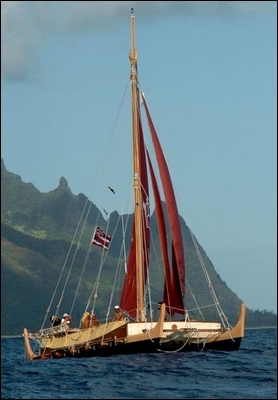Deep Sea Voyaging Canoe Hōkūalaka‘i
Text from 'Aha Punana Leo website
(http://www.ahapunanaleo.org/eng/programs/hokualakai.html)
The deep-sea voyaging canoe Hōkūalaka‘i, "Guiding Star," was constructed as part of a Curriculum, Teacher Training and Recruitment (CTTR) grant in the field of astronomy awarded to the ‘Aha Pūnana Leo (‘APL) in the year 2000 through funding under the Native Hawaiian Education Act (NHEA). Hōkūalaka‘i was proposed as a project that would enhance and supplement Kilo Hōkū, Star Gazer, a grant awarded previously to the ‘APL that was developing curriculum in the field of indigenous astronomy with particular emphasis on Polynesian navigation. The deep-sea voyaging canoe proposed would become a primary tool from which the curriculum being developed could be taught.

Hōkūalaka‘i is navigated by Chad Kalepa Baybayan.
The principle designer and craftsman that constructed Hōkūalaka‘i was Jerry Ongies, a retired Air Force colonel. The design process started by identifying the educational mission of the canoe, the audience it would serve, the resources available for long term maintenance, and the need for the canoe to represent the proud and heralded accomplishments of its mariner ancestors. A design was chosen that conformed to the elegant architectural lines of traditional deep-sea canoes. Because the target audience the canoe would serve would be individuals with relatively little experience in blue water sailing, a more conventional sail rig that would require less deck hands to raise and set the sails was chosen.
Concerns over dwindling native forest reserves and the issue of long-term maintenance were the primary reasons why non-traditional materials were chosen in the construction of the twin 57’ fiberglass hulls. The Marine Education Training Center (METC), a boat construction and maintenance school of the Honolulu Community College, contributed to the design of the hulls by producing computer line drawings of the hulls with hydro-static data that allowed the principal builder to determine water line, draft, weight, balance, trim, and sail placement prior to the canoe being launched. METC also constructed a proto-type mold that allows identical hulls to be replicated in a relatively quick process.
Jay Dowsett provided the expertise in the construction of the hulls, bulkheads, and saddles that the 7 wooden cross pieces that joined the twin hulls together would be lashed on to. Noting that strength, durability, weight, and ease of maintenance would be important considerations in the overall construction and life of the canoe, Jay chose to use composite materials in the lay up of the hulls that utilized a 3/4” Divinucel foam core sandwiched between 5 layers of Knytex 1708 biaxial cloth and vinylester resin. The proto-type mold as well as the unique construction process allows for a well-designed and durable vessel that grass root community groups can utilize to construct canoes of their own.
Jerry Ongies spent over 8,000 hours in custom designing and constructing the hundreds of canoe parts and wiring the electronic and communication system. With a mission in education the canoe has been equipped with a wide range of safety and communication equipment, which includes a high seas radio with email capability. Besides the three sails that can be raised together or reduced as needed, the canoe also carries a 25 HP 4-stroke outboard engine that provides auxiliary power. Tent covers fabricated to fit over the tops of the twin hulls provide the quarters to sleep 8 crewmembers at a time. Master craftsman Wally Froiseth designed the 17’ single steering sweep that provides steerage for the canoe. Deck boxes located throughout the canoe store the galley, pantry, safety, electronics, communication, and general shipboard equipment. The interior spaces below the wash decks of both hulls provide ample space for extra food and water. In support of the developed curriculum, the principal means of navigation is done using traditional non-instrument techniques with a backup GPS system aboard for safety reasons.
Launched in August of 2004, the overall design and construction process has taken about four years. The last year of construction was spent lashing several hundred different canoe parts together to complete assembly of the canoe. Students and new crewmembers contributed over 4,000 hours to the assembly process. In preparation for sailing Hōkūalaka‘i before its launch, prospective crewmembers began their seamanship and navigation training aboard Kea‘eloa, The Eastern Tradewind, a smaller 30’ version of the much larger Hōkūalaka‘i. Kea‘eloa was designed similar to Hōkūalaka‘i so that it could be a stepping-stone in the learning process by providing crew with basic sailing experience aboard a small coastal platform before graduating onto a much larger ocean going vessel.
In 2005, Hōkūalaka‘i completed its first year of sea trials sailing over 1,200 miles and visiting all of the major Hawaiian islands including the 2 remote wild life sanctuaries of Nihoa and Mokumanamana. Based upon what was learned in its first year of sailing and sea trials, Hōkūalaka‘i went under a series of modifications to improve the overall performance of the canoe. Hōkūalaka‘i is expected to return to her homeport of Hilo in the summer of 2006 and along with Kea‘eloa will continue to be platforms that support Hawaiian language development and promote mauli ola Hawai‘i life learning through its program offerings.
Hōkūalaka‘i
Length (overall): 57’
Beam: 17’
Mast: 42’
Spar: 48’
Displacement: 7 tons
17’ steering sweep
Auxiliary power: 25 HP 4 stroke
Solar panels charges electrical systems
Seven main ‘Iako/cross pieces and one forward spreader.
Sails: 850 square feet available (main with 2 jibs)
